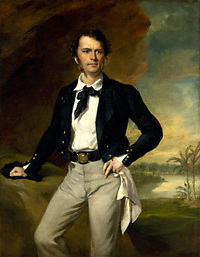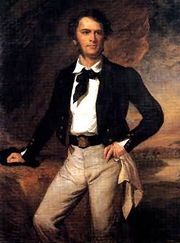James Brooke
| James of Sarawak | |
|---|---|
| The Rajah of Sarawak | |
 |
|
| Sir James Brooke, Rajah of Sarawak | |
| Reign | Rajah of Sarawak - 18 August 1842 - 11 June 1868 |
| Coronation | 18 August 1842 |
| Born | 29 April 1803 |
| Birthplace | Secrore, Benares, India |
| Died | 11 June 1868 |
| Place of death | Burrator, United Kingdom |
| Predecessor | none (post created) |
| Rajah Muda | Charles of Sarawak |
| Successor | Charles |
| Consort | Pengiran Anak Fatima (unconfirmed) |
| Royal House | White Rajahs |
| Father | Thomas Brooke |
James, The Rajah of Sarawak (born James Brooke; 29 April 1803 – 11 June 1868) was the first White Rajah of Sarawak. His father, Thomas Brooke, was English; his mother, Anna Maria, was born in Hertfordshire, the illegitimate daughter of Scottish peer Colonel William Stuart, 9th Lord Blantyre, and his mistress Harriott Teasdale. James Brooke was born in Secrore, a suburb of Benares, India.
Contents |
Early life
James stayed at home in India until he was sent, aged 12, to England and a brief education at Norwich School from which he ran away. Some home tutoring followed in Bath before he returned to India in 1819 as an ensign in the Bengal Army of the British East India Company. He saw action in Assam during the First Anglo-Burmese War until seriously wounded in 1825, and sent to England for recovery. In 1830, he arrived back in Madras but was too late to rejoin his unit, and resigned. He remained in the ship he had travelled out in, the Castle Huntley, and returned home via China.
Sarawak
He attempted to trade in the Far East, but was not successful. In 1833, Brooke inherited £30,000, which he used as capital to purchase a 142-ton schooner, The Royalist[1]. Setting sail for Borneo in 1838, he arrived in Kuching in August to find the settlement facing a Bidayuh uprising against the Sultan of Brunei. Offering his aid to the Sultan, he and his crew helped bring about a peaceful settlement. Having threatened the Sultan with military force, he was granted the title of Raja of Sarawak on 24 September 1841[2], although the official declaration was not made until 18 August 1842.
Brooke began to establish and cement his rule over Sarawak: reforming the administration, codifying laws and fighting piracy, which proved to be an ongoing issue throughout his rule. Brooke returned temporarily to England in 1847, where he was given the Freedom of the City of London, appointed governor and commander-in-chief of Labuan, British consul-general in Borneo and was created a Knight Commander of the Order of the Bath.
Brooke became the centre of controversy in 1851 when accusations of misconduct against him led to the appointment of a royal commission in Singapore. Its investigation did not confirm the charges, but the accusations continued to haunt him.
During his rule, Brooke faced threats from Sarawak warriors like Sharif Masahor and Rentap, but remained in power.
Having no legitimate children, in 1861 he named Captain John Brooke Johnson-Brooke, his sister's oldest son, as his successor. Two years later, while John was in England, James deposed and banished John from Sarawak because John had criticised him. He later named another son of the same sister, Charles Anthoni Johnson Brooke, who did indeed succeed him.
He ruled Sarawak until his death in 1868, following three strokes over a period of ten years. He is buried in Sheepstor church near Burrator, Plymouth, as are his successors.
Personal life

Throughout his life, Brooke's principal emotional bonds were with adolescent boys, though his biographer and contemporary Spenser St. John gives an account of his love for and brief engagement to the daughter of a Bath clergyman. He also left a son (see below). Among his more notable relationships with boys was the one with Badruddin, a Sarawak prince, of whom he wrote, "my love for him was deeper than anyone I knew." Later, in 1848, Brooke fell in love with 16 year old Charles T. C. Grant, grandson of the seventh Earl of Elgin, who reciprocated [3][4]. Victorian interpretations of these events differ from the accounts here cited.
Brooke was influenced by the success of previous British adventurers and the exploits of the British East India Company. His actions in Sarawak were clearly directed to both expanding the British Empire and the benefits of its rule, assisting the local people by fighting piracy and slavery, and securing his own personal wealth to further these activities. His own abilities, and those of his successors, provided Sarawak with excellent leadership and wealth generation during difficult times, and resulted in both fame and notoriety in some circles. His appointment as Rajah by the Sultan, and his subsequent knighthood, is evidence that his efforts were widely applauded in both Sarawak and British society.
Although he died unmarried, he did acknowledge one son. Neither the identity of the son's mother nor his birthdate is clear. The son was brought up as Reuben G. Walker in the Brighton household of Frances Walker (1841 and 1851 census, apparently born ca.1836). By 1858 he was aware of his Brooke connection and by 1871 he is on the census at the parish of Plumtree, Nottinghamshire as 'George Brooke', age '40', birthplace 'Sarawak, Borneo.' He was married (in 1862 [1]) and had seven children, three of whom survived their infancy; the oldest was called James. He died, travelling steerage to Australia, in the wreck of the SS British Admiral[2] on 23 May 1874.; a memorial to this effect - giving a birthdate of 1834 - is in the churchyard at Plumtree [3].
Fiction
Fictionalised accounts of Brooke's exploits in Sarawak are given in Kalimantaan by C. S. Godshalk and The White Rajah by Nicholas Montserrat. Brooke is also featured in Flashman's Lady, the 6th book in George MacDonald Fraser's meticulously researched Flashman novels; and in Sandokan: The Pirates of Malaysia (I pirati della Malesia), the second novel in Emilio Salgari's Sandokan series. Additionally, Brooke was a model for the hero of Joseph Conrad's novel Lord Jim, and he is briefly mentioned in Kipling's short story "The Man Who Would Be King".
Burial
All three White Rajas are buried in St Leonard's Church in the village of Sheepstor on Dartmoor.
Honours
Some Bornean species were named in Brooke's honor:
- Rhododendron brookei, Rhododendron
- Raja Brooke's Pitcher Plant, Nepenthes rajah, a pitcher plant named by Joseph Dalton Hooker
- Trogonoptera brookiana, birdwing butterfly, named by Alfred R. Wallace
- Brooke's Squirrel, Sundasciurus brookei
|
James Brooke
Brooke family
Born: 29 April 1803 Died: 11 June 1868 |
||
| Regnal titles | ||
|---|---|---|
| Preceded by None |
Rajah of Sarawak 1842-1868 |
Succeeded by Charles |
Notes
- ↑ James, Lawrence (1994). The Rise and Fall of the British Empire. 175 Fifth Avenue, New York, N.Y. 10010: St. Martin's Griffin. pp. 244–245. ISBN 0-312-16985.
- ↑ "JAMES BROOKE, FIRST RAJA OF SARAWAK". http://www.rajahbrooke.com/datesjam.htm. Retrieved 2008-08-30.
- ↑ Empire and Sexuality: The British Experience, Ronald Hyam; pp.44-45
- ↑ WALKER, J.H., "This peculiar acuteness of feeling: James Brooke and the enactment of desire", Borneo Research Bulletin, vol 29 (1998) pp 148- 189
References
- Barley, Nigel. White Rajah. London:Time Warner, 2002 ISBN 978-0316859202
- Cavendish, Richard. "Birth of Sir James Brooke." History Today. April 2003, Vol. 53, Issue 4.
- Doering, Jonathan. "The Enigmatic Sir James Brooke." Contemporary Review, July, 2003. (Book review of White Rajah by Nigel Barley. Little, Brown. ISBN 0-316-85920-6.)
- Jacob, Gertrude Le Grand. The Raja of Saráwak: An Account of Sir James Brooks. K. C. B., LL. D., Given Chiefly Through Letters and Journals. London: MacMillan, 1876.
- Rutter, Owen (ed) Rajah Brooke & Baroness Burdett Coutts. Consisting of the letters from Sir James Brooke to Miss Angela, afterwards Baroness, Burdett Coutts 1935.
- Wason, Charles William. The Annual Register: A Review of Public Events at Home and Abroad for the Year 1868. London: Rivingtons, Waterloo Place, 1869. pp. 162-163.